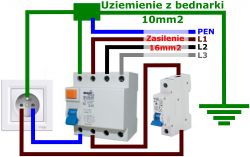I warmly welcome!
Yesterday I assembled a switchgear at a construction site in which I also have a residual current device.
The installation works fine, but the switch doesn't seem to be.
I connected it like in the picture below:

Everything works fine, but I decided to check the differential and something is probably wrong.
I found a video on the Internet in which it is explained that the differential can be checked by shorting the PE security pin with the neutral N. The differential should work then, but I have no reaction. After pressing the TEST jacking, the differential switches off, but there is no reaction when PE and N are short-circuited.
The figure shows a fragment of the installation. Of course, all 3 phases are used, but similarly to the one shown in the figure.
I thought that maybe I would replace the N and PE conductors connected to the differential, i.e. I would attach PE at the bottom, and N at the top.
It turned out that with such a connection, the differential turns off as soon as I turn something on, and if I try to turn on the differential, e.g. with a lamp connected, it turns off immediately and cannot be turned on at all.
Is the connection in the drawing correct, or is it with reversed N and PE conductors?
I have a differential exactly as shown in the attached photo.
Yesterday I assembled a switchgear at a construction site in which I also have a residual current device.
The installation works fine, but the switch doesn't seem to be.
I connected it like in the picture below:

Everything works fine, but I decided to check the differential and something is probably wrong.
I found a video on the Internet in which it is explained that the differential can be checked by shorting the PE security pin with the neutral N. The differential should work then, but I have no reaction. After pressing the TEST jacking, the differential switches off, but there is no reaction when PE and N are short-circuited.
The figure shows a fragment of the installation. Of course, all 3 phases are used, but similarly to the one shown in the figure.
I thought that maybe I would replace the N and PE conductors connected to the differential, i.e. I would attach PE at the bottom, and N at the top.
It turned out that with such a connection, the differential turns off as soon as I turn something on, and if I try to turn on the differential, e.g. with a lamp connected, it turns off immediately and cannot be turned on at all.
Is the connection in the drawing correct, or is it with reversed N and PE conductors?
I have a differential exactly as shown in the attached photo.


